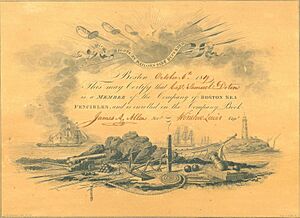Sea Fencibles (American) facts for kids
The Sea Fencibles were special groups of sailors and boatmen. They were created to protect America's coasts and harbors, especially during the War of 1812 and the American Civil War. Think of them as a coastal defense team. They were similar to groups in Britain that did the same job.
Contents
Sea Fencibles in the War of 1812
Quick facts for kids United States Sea Fencibles |
|
|---|---|
| Active | 1813–1815 |
| Country | United States |
| Branch | United States Navy |
| Role | Coastal defence |
| Size | c. 1,000 men |
"... within the five cities of Boston, New York, Philadelphia, Baltimore and Norfolk, there are a large number of seafaring men, who from their hardihood and habits of life, might be very useful in the defense of the seaboard, particularly in the management of the great guns...."
During the War of 1812 against the United Kingdom, the United States needed strong coastal defenses. On July 26, 1813, the United States Congress passed a law. This law allowed the creation of the Sea Fencibles. They could serve for up to one year. The law permitted up to ten companies of these defenders. Their main job was to protect American ports and harbors.
Baltimore's Defenders
In Baltimore, two companies of Sea Fencibles were formed. Captains Matthew S. Bunbury and William H. Addison led these groups. Most of these men were sailors by trade. The War Department managed them.
Their officers received the same uniforms, pay, and food as Army officers. The rest of the company, like boatswains, gunners, and privates, got Navy uniforms, pay, and food. Each company had 107 officers and enlisted men.
| No. | Rank | Pay |
|---|---|---|
| 1 | Captain | $40 |
| 1 | First Lieutenant | $30 |
| 1 | Second Lieutenant | $25 |
| 1 | Third Lieutenant | $23 |
| 1 | Boatswain | $20 |
| 6 | Gunners | $20 |
| 6 | Quarter-gunners | $18 |
| 90 | Privates | $12 |
The Sea Fencibles in Baltimore were part of the regular defense. Captain Bunbury's company stayed at Fort McHenry. Addison's men were at Fort Covington. Their duties included operating boats, keeping up a special chain barrier, and standing guard. They also helped fire the large cannons at Fort McHenry.
Boston's Sea Fencibles
A similar group was formed in Boston in early 1814. This company included sailors who didn't have jobs. It also had wealthier men who wanted to serve in a more exciting way than regular land-based soldiers. For the Boston group, being a Sea Fencible was more than just military service.
Besides defending the coast, members were encouraged to help their community. They were expected to do good deeds and charity work. The group's rules stated that every good person in New England should help. They should offer their services with enthusiasm.
The Boston Sea Fencibles became very popular. Local people gave them many donations. These donations paid for their uniforms. The uniform included a hat made of tarpaulin, a blue short jacket, and trousers. They also had weapons like a cutlass and a boarding pike.
Their headquarters was a gun-house near the Providence naval depot. Captain Nehemiah Skillings was their leader. They had 18-pounder and 24-pounder cannons to use. They practiced shooting these cannons on open ground near Boston's City Point. The company officially ended when the war with Britain finished on December 24, 1814.
On March 3, 1815, Congress canceled the law that created the Sea Fencibles. However, some companies continued to operate for several more years.
Sea Fencibles in the Civil War
During the American Civil War, there were also Sea Fencibles in the Confederate States Army. One group in Charleston was called "Symon's Sea Fencibles." John Symon organized this unit. They were a land-based group. Their job was to watch the coast. They probably wore regular clothes instead of uniforms.
One of their officers was Hispanic. There are no records that this unit ever fought in a battle. Many members were unhappy because they received only $11 in pay from the Confederacy. They wanted the $15 pay that the Union Navy offered. Because of this, the unit broke up by the end of 1861. Its members likely joined other local military groups.


